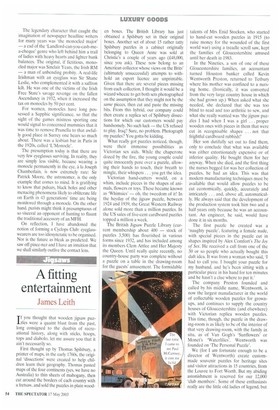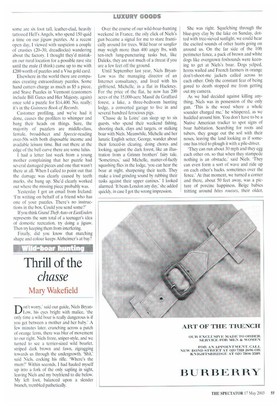A fitting entertainment
James Leith
If you thought that wooden jigsaw puzzles were a quaint blast from the past, long consigned to the dustbin of recreational history, along with sticks, hoops, tops and diabolo, let me assure you that it ain't necessarily so.
First thought up by Thomas Spilsbury, a printer of maps, in the early 1760s, the original 'dissections' were created to help children learn their geography. Thomas pasted maps of the four continents (yes, we have no Australia) to thin sheets of mahogany, then cut around the borders of each country with a fretsaw, and sold the puzzles in plain wood
en boxes. The British Library has just obtained a Spilsbury set in their original boxes. Another set of about 15 rather tatty Spilsbury puzzles in a cabinet originally belonging to Queen Anne was sold at Christie's a couple of years ago (£48,000, since you ask). These now belong to an American collector whose views on the Brits' (ultimately unsuccessful) attempts to withhold an export licence are unprintable. Given that there are several pieces missing from each collection, I thought it would be a wizard wheeze to get both sets photographed on the assumption that they might not be the same pieces, then cut and paste the missing bits. From this hybrid, our company could then create a replica set of Spilsbury dissections for which our customers would pay handsomely. No such luck — the US refused to play. Iraq? Sure, no problem. Photograph my puzzles? You gotta be kidding.
What really got puzzles noticed, though, were their immense possibilities as Victorian sex aids. While the chaperone dozed by the fire, the young couple could quite innocently pore over a puzzle, allowing their hands to touch, their breath to mingle, their whispers. . . you get the idea.
Victorian hand-cutters would, on a whim, include pieces in the shapes of animals, flowers or toys. These became known as 'Whimsies' — oh, the tweedom of it! In the heyday of the jigsaw puzzle, between 1924 and 1939, the Great Western Railway alone sold more than a million puzzles. In the US sales of five-cent cardboard puzzles topped a million a week.
The British Jigsaw Puzzle Library (current membership about 400 — stock of puzzles 3,500) has flourished in various forms since 1932, and has included among its members Clem Attlee and Her Majesty the Queen. Until really quite recently, no country-house party was complete without a puzzle on a table in the drawing-room for the guests' amusement. The formidable talents of Mrs Enid Stocken, who started to hand-cut wooden puzzles in 1915 (to raise money for the wounded of the first world war) using a treadle scroll saw, kept the families of Gloucestershire amused until her death in 1983.
In the Nineties, a son of one of these Gloucestershire families, an accountant turned Houston banker called Kevin Wentworth Preston, returned to Tetbury where his mother was confined to a nursing home. (Ironically, it was converted from the very large country house in which she had grown up.) When asked what she needed, she declared that she was too blind to read and too arthritic to sew, and what she really wanted was 'the jigsaw puzzles I had when I was a girl . . . proper wooden ones with pieces in them that were cut in recognisable shapes . . . not that frightful cardboard rubbish!'
Her son dutifully set out to find them, only to conclude that what was available was either extortionately expensive or of inferior quality. He bought them for her anyway. When she died, and the first thing the nurses begged for was her collection of puzzles, he had an idea. This was that modern manufacturing techniques must be available that would allow puzzles to be cut economically, quickly, accurately and intricately . . and, above all, automatically. He always said that the development of the production system took him two and a half years only because he was an accountant. An engineer, he said, would have done it in six months.
The first puzzle he created was a 'naughty puzzle', featuring a female nude, with special pieces in the puzzle cut in shapes inspired by Alex Comfort's The Joy of Sex. He received a call from one of the 30 or so people who actually bought this daft idea. It was from a woman who said, 'I had to call you. I bought your puzzle for my husband, and he's been sitting with a particular piece in his hand for ten minutes and he hasn't a clue where to put it.'
The company Preston founded and called by his middle name, Wentworth, is now the largest manufacturer in the world of collectable wooden puzzles for grownups, and continues to supply the country houses of Gloucestershire (and elsewhere) with Victorian replica wooden puzzles. This time, though, the puzzle in the drawing-room is as likely to be of the interior of that very drawing-room, with the family in situ, as of Van Gogh's 'Sunflowers' or Monet's Waterlilies'. Wentworth was founded on 'The Personal Puzzle'.
We (for I am fortunate enough to be a director of Wentworth) create custommade souvenir puzzles for heritage sites and visitor attractions in 15 countries, from the Louvre to Fort Worth. But my abiding astonishment is reserved for our 12,000 'club members'. Some of these enthusiasts really are the little old ladies of legend, but some are six foot tall, leather-clad, heavily tattooed Hell's Angels, who spend 150 quid a time on our jigsaw puzzles. At a recent open day, I viewed with suspicion a couple of crusties (20-30, dreadlocks) wandering about the factory. I thought they'd mistaken our rural location for a possible rave site until the male (I think) came up to me with £200 worth of puzzles and a Visa gold card.
Elsewhere in the world there are companies creating extraordinary puzzles. Some hand cutters charge as much as $5 a piece, and Stave Puzzles in Vermont (customers include Bill Gates and Her Majesty, again) once sold a puzzle for $14,400. No, really; it's in the Guinness Book of Records.
Customer profiling, and we've had it done, causes the profilers to whimper and bang their heads on things. Sure, the majority of puzzlers are middle-class, female, broadsheet and Speccie-reading over-50s with both disposable income and available leisure time. But out there at the edge of the bell curve there are some lulus.
I had a letter last week from a young mother complaining that her puzzle had several damaged pieces and one that wasn't there at all. When I called to point out that the damage was clearly caused by teeth marks, she hung up. She'd clearly worked out where the missing piece probably was.
Yesterday I got an email from Ireland: 'I'm writing on behalf of a friend who has one of your puzzles. There's no instructions in the box. Could you send some?'
If you think Grand Theft Auto or EastEnders represents the sum total of a teenager's idea of domestic recreation. try doing a jigsaw. Then try keeping them from interfering.
Finally, did you know that matching shape and colour keeps Alzheimer's at bay?



































































































 Previous page
Previous page